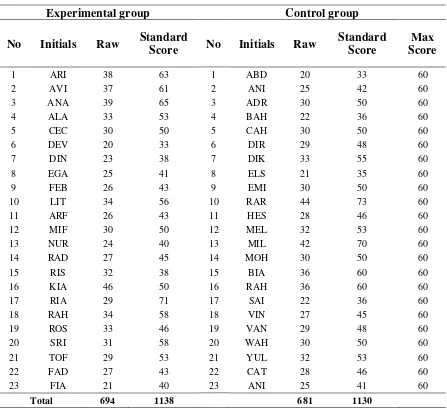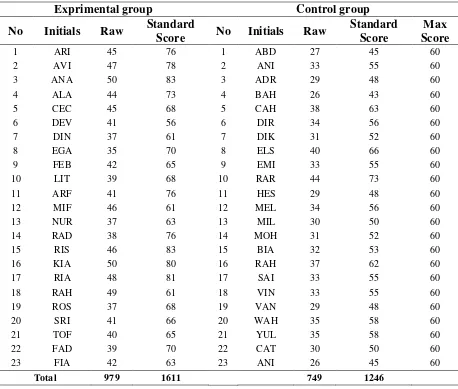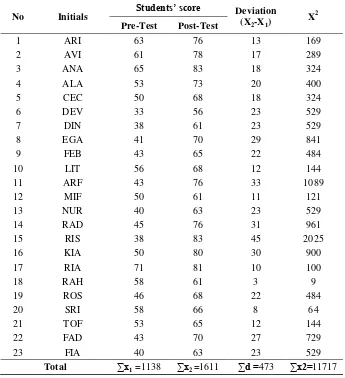e-Journal of English Language Teaching Society (ELTS) Vol. 2 No. 4 2014 – ISSN 2331-1841 Page 1
IMPROVING VOCABULARY MASTERY OF THE EIGHT GRADE
STUDENTS THROUGH SONG
Risnawati1, Nuhung.B2, Nursehang Thamrin3Abstract
The objective of this study was to improve the student’s vocabulary mastery through song. The population of this research was the eight grade students of MTs Negeri Taipa Palu. A true exprimental design and random sampling technique were used in conducting this research. The researcher took the eight grade strudents as the sample consisting of 46 students. The data were collected through observation and tests; pretest and posttest. Observation was conducted to get information about the teaching learning process in the classroom while the pre-test and post-test were used to find out the improvement of the students’ vocabulary mastery before and after the treatment. Based on the result of pretest and posttest the research found that the t-counted value (5.276) was greater than t-table (2.017) by applying 0.05 level of significance and the degree of freedom (df) 44. It means that the hypothesis of this research is accepted. In other words, the use of song was effective to increase student’s vocabulary mastery.
Key words: Vocabulary Mastery; Song.
INTRODUCTION
Vocabulary is one of the language components that must be mastered first by the students if they want to learn or master English. Therefore, it is important to note that vocabulary mastery should be taught to the students so that they can have and recognize more words. Having or knowing more stock of words makes the students get easier to know and to select what words they are going to use appropriately both in learning and using English.
Thornbury (2002:3) states:
If you spend most of your time studying grammar, your English will not improve very much. You will see most improvement if you learn more words and expressions. You can say very little with grammar but you can say almost anything with words.
e-Journal of English Language Teaching Society (ELTS) Vol. 2 No. 4 2014 – ISSN 2331-1841 Page 2 Based on preliminary observation to the eight grade students of MTs. Negeri Taipa Palu, it was found the students were lack of vocabulary. They were not able to differenciate the classes of word. Also, the students are still confused in understanding and mastering the meaning of the words or instructional material presented in English. In line with this situation, the English teacher needs to apply an appropriate technique in teaching vocabulary. One of the effective ways is by using song.
Song is short musical composition containing vocal parts that are performed with human voice and generally feature words (lyrics), by other musical instrument. Cullen (1998) confirms that song is significant teaching tools in teaching English because most of the students love listening to the music, it make them easier to memorize the words while singing. The use of song is intended to make learning atmosphere be more interesting and enjoyable.
Lo & Li (1998:9) states, “Songs provide a break from classroom routine, and that learning English through songs develop a classroom atmosphere in which the four language skill can be enhanced”. Students are often willing to learn to sing a song in a foreign language even if they do not fully understand or partially understand the meaning of the words. This allows them a chance to relax from the pressure of the study. Students listen to all kinds of music outside the classroom. Music is very enthusiastic when teachers choose to exploit songs in the classroom. Songs have a great tendency to attract the attention of the students. Songs deal with the human problems and emotions from love, hate, joy, and sadness. They really appeal to the young learners.
Using English song is considered because songs have many values of language. Orlova (2003:2) suggests purposes of songs in the classroom, they are:
a. Practicing the rhythm, stress and the intonation patterns of the English language. b. Teaching vocabulary, especially in the vocabulary reinforcement stage
c. Teaching grammar. In this respect songs are especially favored by teachers while investigating the use of the tenses.
d. Teaching speaking. For this purpose, songs and mainly their lyrics are employed as a stimulus for class discussion.
e. Teaching listening comprehension.
e-Journal of English Language Teaching Society (ELTS) Vol. 2 No. 4 2014 – ISSN 2331-1841 Page 3 The researcher chose the grade eight students at MTs Negeri Taipa Palu as the population of this research because she wanted to improve their vocabulary mastery. The researcher formulated the problem statement as follow: Can the use of songs improve the students’ vocabulary mastery at the grade eight students of MTs.Negeri Taipa Palu? The aim was to find out that the use of song can improve vocabulary mastery of the grade eight students at MTs Negeri Taipa Palu.
METHODOLOGY
In conducting this research, the researcher used true experimental research which required two groups. They were experimental and control groups. The treatment was administrated only for the exprimental group while the control group was not. The same pre test and post test were distributed to these both groups. The formula used in this reserach could be seen as follows (Suryabrata,1983:105).
Group Pre-test Treatment Post-test
Exp.Group T1 X T2
Contr.Group T1 T2
Where;
T1 = pre-test T2 = post-test X = treatment
In every research, there is a population that is really important to support the research itself. The researcher took the grade eight students of MTs. Negeri Taipa Palu. It has four parallel classes. They were class A, B, C, and D. Each class consisted of 20 up to 28 students. Therefore, the total number is 92.
e-Journal of English Language Teaching Society (ELTS) Vol. 2 No. 4 2014 – ISSN 2331-1841 Page 4 In collecting the data, the researcher used tests consisting of pre-test and post-test. Those were used to measure the students’ vocabulary mastery. Pre-test was used to measure the students’ comprehension level in vocabulary before they were given the treatment. Post-test was used to know whether the treatment was effective or not. Also, the researcher could see the students’ progress after they were given the treatment. The scoring system was presented in the following table:
Table 1: The Scoring System of the Test
No Test Items Score of Items Maximum Score
1. Multiple Choice 40 1 40
2. Word
Completion 20 1 20
Total 60
After delivering the pre-test to the students, The treatment was conducted for sixteen times excluding pre-test and post-test. The treatment was for the experimental group. Meanwhile, the control one was given a conventional method.
To know the ability of the students in vocabulary mastery, the researcher computed the score that has been obtained during teaching learning process by applying the formula proposed by Margono (1996: 208) as follows:
Where:
NP = student’s individual score R = raw score
SM = maximum score 10 = constant number
The researcher computed the students’ mean scores by using formula as proposed by Gay (1996:449):
=
Where:
= mean score
e-Journal of English Language Teaching Society (ELTS) Vol. 2 No. 4 2014 – ISSN 2331-1841 Page 5 To compute the result of variance, the researcher employed the following formula proposed by Gay (1996:486) as follows:
= –
Where:
= sum of squares ∑ = sum of square score (∑ = square of the sum N = total of number subjects
Finally, the researcher computed the result of the mean score and square deviation to know if there was a significant difference in the results of pre-test and post-test by using the formula proposed by Gay (1996:486)
t =
Where:
= mean of experimental group = mean of control group
= sum of squares on of experimental group = sum of squares of control group
= number of experimental group = number of control group
RESEARCH FINDINGS
e-Journal of English Language Teaching Society (ELTS) Vol. 2 No. 4 2014 – ISSN 2331-1841 Page 6
Table 2: The pre-test score of experimental group and control group
Experimental group Control group experimental group in pre-test by using a formula as follows:
= =
e-Journal of English Language Teaching Society (ELTS) Vol. 2 No. 4 2014 – ISSN 2331-1841 Page 7
Table 3: The post-test score of experimental group and control group
Exprimental group Control group
The researcher computed the students’ mean score of the experimental and control groups in post-test by using formula:
=
=
= = 70.04 = 54.17
e-Journal of English Language Teaching Society (ELTS) Vol. 2 No. 4 2014 – ISSN 2331-1841 Page 8
Table 4: The deviation of post-test and pre-test score of experimental class
No Initials Students’ score Deviation (X2-X1)
The computation of the mean is shown below
=
= =20.56
After getting the mean deviation, the researcher calculated the score of square deviation of the experimental group by using the following formula:
= –
e-Journal of English Language Teaching Society (ELTS) Vol. 2 No. 4 2014 – ISSN 2331-1841 Page 9 11717–
– 9727.34
1989.66
Table 5
The deviation of post-test and pre-test of control group
No Initials Students’ score Deviation (X2-X1)
The computation of the mean deviation as follows:
=
e-Journal of English Language Teaching Society (ELTS) Vol. 2 No. 4 2014 – ISSN 2331-1841 Page 10 After getting the mean deviation, the researcher computed the sum of square deviation from pre-test and post-test as shown below
= –
2646 – 2646 –
2646 – 585.04
2060.96
To see whether there was a significant difference between the means of the two groups in the post-test, the researcher compared them by using statistical formula as follows:
t =
t =
t =
t =
t = = =5.726
To test the difference between t-counted and t-table, the researcher applied 0.05 level of significance for two-tailed test with 44 degree of freedom (df) 23 + 23 – 2 = 44. Because there is no (df) 44 in the table, the researcher computed by using interpolation in order to find out the value of t-table as follows:
a = 44 – 40 = 4
b = 60 – 40 = 20
c = 40 --- 2.021
e-Journal of English Language Teaching Society (ELTS) Vol. 2 No. 4 2014 – ISSN 2331-1841 Page 11
= 2.021 – 2.00
= 0.02
= 0.004
Df (44) = 2.021 – 0.004
= 2.017
The data were analyzed in order to see the significance difference between the pre-test and post-test by using t-test formula. It was found that t-counted value (5.726) was greater than t-table value (2.017) by applying 0.05 level of significance for two-tailed test with 44 degree of freedom (df) 23 + 23 – 2 = 44 degree of freedom. It means that the use of song can improve the student’s vocabulary mastery.
DISCUSSION
Based on the test result, it shows that after the researcher applied the treatment to the students by using song, it can improve the students’ vocabulary mastery. The most weakness of each student was on the difference of word classes. It can be seen from students’ mean score of experimental and control classes in post-test which was greater than in pre-test. There was a significant difference of students’ mean score between pre-test and post-test before the students got the treatment and after getting the treatment. In this matter, the researcher specified the scope of the research on three classes of words, namely: noun, verb, and adjective aiming at improving the the students’ vocabulary mastery of the grade eight students of MTs negeri Taipa Palu through song.
e-Journal of English Language Teaching Society (ELTS) Vol. 2 No. 4 2014 – ISSN 2331-1841 Page 12
Table 6: The percentage of the students in classes of words
classes of
Based on the table above, both of groups reach the same percentage in adjective class, that is 35%. In verb category, the deviation percentage of two groups was 4% which control group obtained 43% and experimental group reached 48%. The last category belongs to noun. Both of groups gained different percentage which control group got 56% and experimantal group obtained 56%. From the result, the low percentage was in adjective class.
After knowing the result of the pre-test, the researcher applied the treatments to the students by using song in exprimental group, while in control group the researcher treated them by using text book based on the curriculum. The researcher provided different songs to be discussed in every meeting. The treatment was implemented to exprimental group for sixteen meetings.
In order to know the students’ vocabulary improvement, the researcher gave post-test to both of groups. The result of the experimental group in post-test was presented in the following table:
Table 7: The percentage of the students in classes of words
classes of
e-Journal of English Language Teaching Society (ELTS) Vol. 2 No. 4 2014 – ISSN 2331-1841 Page 13 classes of word gained by experimental group was significant. It can be seen from the persentage of adjective class in pre-test was 35% to be 60% in post-test. In the second class of word, verb category gained 47% in pre-test and changed into 69%. The last class, noun required 35% in pre-test and 78% in post-test. In control group, there was no significant difference among three classes of word which was gained by the students.
By seeing at the result from the pre-test and post-test of both groups, the researcher found that by applying song in teaching vocabulary, the students can improve vocabulary mastery especially in differenciating the classes of word.
Regarding to the findings, the researcher found that the previous study written by Yaqin (2008) was “Improving students’ listening skill by using songs (an action research at the second year students of MA Pancasila Bengkulu)”. The result of his research showed that song can improve the students’ skill in listening. It means that this technique was effective to develop the students vocabulary mastery, not only in teaching language component but also in teaching skill, such as listening. Based on the research findings, the reseracher concludes that the use of song has given big contribution to the students’ improvement in learning English.
CONCLUSION AND SUGGESTION
Having discussed and analyzed the data, the researcher draws the conclusion as finding of the research. The researcher found that the use of song can improve the students’ vocabulary mastery at the grade eight students of MTs Negeri Taipa Palu. At the first time, the researcher conducted an observation and found many problems. One of them was that they lack of vocabulary. Before the researcher applied the treatment, the students cannot distinguish some classes of word such as noun, verb, and adjective. Then, after having the treatment, the students started knowing the difference of word classes. Also, they found an enjoyable technique in learning vocabulary.
Considering to the importance of vocabulary mastery in learning English, the researcher would like to give some suggestions for those who get involved in English teaching and learning process.
e-Journal of English Language Teaching Society (ELTS) Vol. 2 No. 4 2014 – ISSN 2331-1841 Page 14 2. The students should study harder. Even though their vocabulary test result was good, they
still need to learn more about vocabulary especially related to the class of words
3. The next researcher should find an enjoyable technique in teaching English especially in vocabulary mastery.
REFERENCES
Cullen, B. (1998). Music and song discussion. The Internet TESL journal. http://iteslj.org (retrieved on march 1st 2013)
Gay, L.R. (1996). Educational Research. New Jersey: Prentice Hall, Inc.
Lo, R. and Li, HC. (1998). “Songs Enhance LearnerInvolvement”.English Teaching Forum.36, 8-11
Margono, S. (1996). Methodology Penelitian Pendidikan. Jakarta: Rineka Cipta.
Orlova, N.F. (2003). Helping Prospective EFL Teachers Learn How to Use Songs in Teaching Conversation Classes. The Internet TESL Journal. http://iteslj.org/Technoques/Orlova-Songs.html
Retrieved on 15th October 2013: 03.02 pm.
Suryabrata, S. (1983). Metode penelitian. Jakarta: PT Raja Grafindo Persada Thornbury, S. (2002). How to Teach Vocabulary. Kuala Lumpur: Longman.




